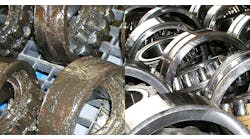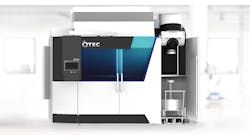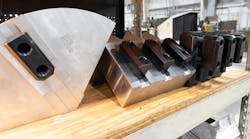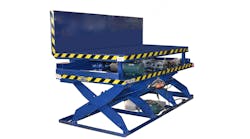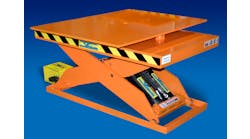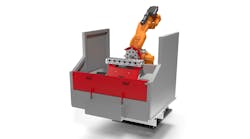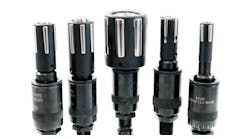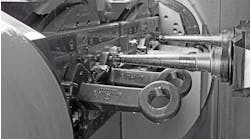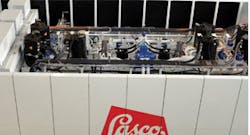Energy is everything in manufacturing, which forgers know as well as anyone. Energy must be available and affordable, but it also must be immediately accessible, reliable and manageable. And, the energy control and delivery functions must be efficient. All of these details matter just as much to manufacturing equipment designers and control engineers as to operators.
“Our new servo technology provides substantial energy savings for companies operating our presses,” according to Harald Barnickel, who heads the Electrical Engineering Department at Lasco Umformtechnik GmbH.
The builder of hydraulic forging presses and screw presses, as well as forging hammers, forging and cross wedge rolls, also has a line of automated hydraulic presses and related machines for producing sand-lime bricks.
“As a solution provider, we develop customized systems for optimized workpiece transport within the press as well as for feeding and removing workpieces,” Barnickel explained. Lasco emphasizes continuous improvement in its processes and technology, and the servo technology is that sort of technological milestone, as demonstrated by its implementation in a recently delivered deep-drawing press with a press force of 800 tons for up to 40 strokes per minute.
At the core of this solution — directly driving the hydraulic pump — is a Simotics 1PH8 servomotor, a product of Siemens Automation. This drive is controlled by the Sinamics S120 drive platform. A Simotion D445 motion control system handles the complete path, velocity, and position control of the axes.
With a response time of 250 µs, up to 256 axes can be synchronized quickly and precise axis motion and curve profiles are executed. “The initial applications have demonstrated that this type of servo technology provides outstanding results,” said Barnickel, noting the drive’s closed-loop control performance as well as its energy efficiency.
The challenge on the deep drawing press was to control the press force and press speed, based on a motion profile that could be set individually. The hydraulic force can be adjusted at the servomotor by means of the torque. The plunger speed is controlled by the motor speed and thus by the volumetric flow rate of the pump. Axial reciprocating pumps with a fixed displacement per revolution were used for the project described here.
Four such pump systems, connected simultaneously for a maximum pressure of 250 bar, supply the pressure line for the press stroke of the plunger; three additional pump systems are responsible for the return stroke of the press plunger. “The possibility of scaling, in other words adapting this kind of standard servo solution to the actual requirements, is another advantage of this new technology that certainly cannot be underestimated,” noted Barnickel.
The hydraulic oil tank of the deep drawing press holds about 2,377 gallons (9,000 liters). Because of the high flow rate of 16,000 l/min, filling valves are used for the fast downward motion of the plunger. The servo pumps provide the required flow rate for the actual pressing operation, with a speed of up to 100 mm/s.
In the past, high-precision control valves with zero overlap were necessary to obtain the precise traversing profiles. Today, this function is handled by the motion control system, in conjunction with the servo pumps. Thanks to this new technology, the valve systems in the press can be reduced by up to 40%. The remaining valve technology is mainly needed to comply with machine safety specifications.
Energy milestone
As a result of the new technology, expensive, traditional valve systems were eliminated, and energy efficiency has been improved significantly. “In the past, the large cooling systems for the hydraulic oil had to be installed before the first test run at Lasco,” Barnickel recalled. “But now, with servo technology, significantly smaller units can be used, and they are not required until the press is actually operational at the customer’s facility.”
One reason for this is that the oil is no longer forced through the narrow gaps at the control edges of the control valves, which means that these types of technology-related losses no longer occur in the first place. Lasco is seeing efficiency improvements well into the double-digit range (depending on the application) significantly reducing users’ electricity costs compared to older machines.
Comparing the new technology with basic hydraulic presses using conventional technology, the amount of energy saved is certainly less than with presses equipped with complex control systems. The energy-saving effect is especially apparent during the drawing operation, when pressure is provided by a pump equipped with a servomotor, with the motor of the die cushion pump thereby operating as a generator.
Another advantage of the electrical system used here is that energy can actually be recovered when the hydraulic fluid decompresses. This happens when the system is decompressed after the pressing operation and the main cylinder pressure must be reduced from 250 bar down to approximately 10 bar before the filling valve to the tank can be released. This operation takes approximately 100 ms.
In the case of a compressibility of the hydraulic oil used of approximately 2.5% by volume, with a cylinder volume of approximately 800 liters of oil, the “spring energy” in the oil flows through the axial reciprocating pump and drives the servomotor. This effect is amplified when the press mechanical system is relieved. In this so-called generator or regenerative operation, the corresponding electrical energy is fed into the DC link of the S120 drive during each cycle. In addition to the energy recovered, another advantage is that there are no additional power losses via heat, Barnickel explained.
Although the Siemens Simotion controller has been optimized to address motion control applications, Simotion can control the complete system too. However, Lasco’s philosophy is to separate the various press tasks, and therefore it uses a separate PLC for the system control. As a fail-safe control, this also addresses the safety technology requirements. Simotion can be programmed in various ways, for instance, with high-level-language, graphic programming, or Motion Control Chart (MCC) as well as a classic logic control. The trace function with eight-channel plotter supports commissioning engineers and ensures detailed documentation of the press operation. Control parameters are saved in the drive, which guarantees seamless documentation of the drive system.
Safety technology simply integrated
The fail-safe Simatic S7-319 F 3PN/DP PLC from Siemens, used here as the press system control, allows all safety technology to be implemented without any major additional expense. The fail-safe signals are read via distributed Simatic ET200S I/O stations from the same manufacturer and transferred to the control via Profisafe. This represents a simple yet complete solution for the Lasco engineer, who noted, “As a consequence, we obtain a clear machine structure.”
For instance, there are generally two monitored valves, which monitor the reduced traversing speed of the plunger, when setting up. The new solution is far more precise, where the fail-safe S120 drive also monitors the reduced speed (Safely Limited Speed: SLS) as well as a safe stop (Safe Stop 1: SS1).
The press experts at Lasco also view the integrated, seamless nature of the Siemens systems as a benefit. For example, the drive automatically identifies the servomotor and reads its parameters. Another interesting feature of this servo solution is that the 1PH8 motors are available as either synchronous or asynchronous motors. The application itself, or more specifically, the dynamic performance required, is the decisive element in selecting the appropriate motor type, according to Barnickel.
Both versions have the same mechanical mounting dimensions, wiring, and encoder connection. Here, too, the technology has some significant advantages. For instance, instead of a typical 17-core cable, a single cable with RJ45 connector is sufficient.
Finally, this new drive concept for hydraulic presses, based on a servo-electric pump control, results in a significant overall improvement: “In addition to the energy savings, its extremely precise controllability is far superior to that of a classic valve control,” said Harald Barnickel. He noted further that any defined motion profiles can be implemented precisely using this concept.
The motion control system has proven itself to be extremely valuable in certain steps of the pressing process. For instance, if the plunger moves to upper dead center, then the closed-loop position control in Simotion ensures that any leakages are compensated. “A far higher precision is achieved when using servo technology than when using pure valve technology,” Barnickel summarized.
The development of new servo technology for large hydraulic presses, based on the Siemens Simotion motion control system, already has stirred significant interest among Lasco’s customers. However, it is not only when building new machines that this machine builder benefits from lower costs and improved quality; the drive concept is suitable for modernization and retrofit projects also.
With the standard concept, comprising the Simotics 1PH8 servomotor, the Sinamics S120 drive platform and the motion control unit, Lasco has demonstrated that, when hydraulic presses are equipped with servo-electric pump drives instead of pure valve technology, the dynamic performance, precision and especially energy consumption on the press are improved. This results in tangible press improvements that are recognizable by machine designers and machine operators alike.


